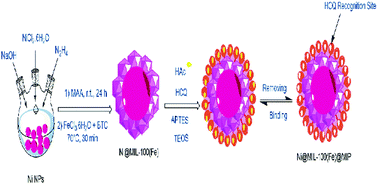Fabrication of a magnetic metal–organic framework molecularly imprinted polymer for extraction of anti-malaria agent hydroxychloroquine†
Abstract
In this article, for the first time, a new magnetic metal–organic framework molecularly imprinted polymer sorbent based on magnetic Ni nanoparticles, named Ni@MIL-100(Fe)@MIP, was synthesized and employed for the determination of hydroxychloroquine sulfate by a dispersive micro-solid phase extraction (DMSPE) method. The imprinted layer was introduced on the surface of a core–shell magnetic metal–organic framework (MMOF) as a substrate. The sorbent was characterized by Fourier transform-infrared (FTIR) spectroscopy, scanning electron microscopy (SEM), vibrating sample magnetometry (VSM), X-ray powder diffraction (XRD), energy dispersive X-ray (EDX) and Brunauer Emmett Teller (BET) methods. The effects of various parameters such as the pH, ionic strength of the sample solution, amount of sorbent (mg), volume of eluent solvent (μL), vortex time, and ultrasound time (min) were optimized by a Box–Behnken design and combined by a desirability function (DF). Under optimum conditions, the calibration graph of the analyte was linear in the concentration range of 1–300 μg L−1, with a correlation of determination (r2) of 0.9927. The limit of detection and quantification were 0.2 and 0.67 μg L−1, respectively. This procedure was successfully applied to the determination of the analyte in a real sample and spiked real sample followed by high performance liquid chromatography (HPLC) analysis. The relative mean recoveries ranged from 96 to 103%.



 Please wait while we load your content...
Please wait while we load your content...